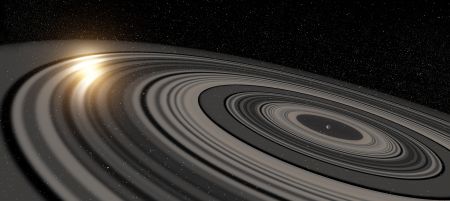 Astronomers at the Leiden Observatory, The Netherlands, and the University of Rochester, USA, have discovered that the ring system that they see eclipse the very young Sun-like star J1407 is of enormous proportions, much larger and heavier than the ring system of Saturn. The ring system – the first of its kind to be found outside our solar system – was discovered in 2012 by a team led by Rochester’s Eric Mamajek.
Astronomers at the Leiden Observatory, The Netherlands, and the University of Rochester, USA, have discovered that the ring system that they see eclipse the very young Sun-like star J1407 is of enormous proportions, much larger and heavier than the ring system of Saturn. The ring system – the first of its kind to be found outside our solar system – was discovered in 2012 by a team led by Rochester’s Eric Mamajek.
A new analysis of the data, led by Leiden’s Matthew Kenworthy, shows that the ring system consists of over 30 rings, each of them tens of millions of kilometers in diameter. Furthermore, they found gaps in the rings, which indicate that satellites (“exomoons”) may have formed. The result has been accepted for publication in the Astrophysical Journal.
The researchers encourage amateur astronomers to help monitor J1407, which would help detect the next eclipse of the rings, and constrain the period and mass of the ringed companion. Observations of J1407 can be reported to the American Association of Variable Star Observers (AAVSO). In the meantime the astronomers are searching other photometric surveys looking for eclipses by yet undiscovered ring systems.
Read the full story at University of Rochester Newscenter
Read the new paper on astro-ph

